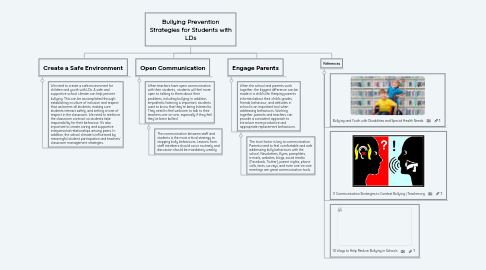Bullying Prevention Strategies for Students with LDs
by Marissa Rossi


1. Create a Safe Environment
1.1. We need to create a safe environment for children and youth with LDs. A safe and supportive school climate can help prevent bullying. This can be accomplished through: establishing a culture of inclusion and respect that welcomes all students, making sure students interact safely, and setting a tone of respect in the classroom. We need to reinforce the classroom contract so students take responsibility for their behaviour. It's also important to create caring and supportive interpersonal relationships among peers. In addition, the school climate is influenced by meaningful student participation and teachers’ classroom management strategies.
2. Open Communication
2.1. When teachers have open communication with their students, students will feel more open to talking to them about their problems, including bullying. In addition, empathetic listening is important. students want to know that they’re being listened to. They need to feel welcome to talk to their teachers one-on-one, especially if they feel they’ve been bullied.
2.1.1. The communication between staff and students is the most critical strategy to stopping bully behaviours. Lessons from staff members should occur routinely and discussion should be mandatory weekly.
3. Engage Parents
3.1. When the school and parents work together, the biggest difference can be made in a child’s life. Keeping parents informed about their child’s grades, friends, behaviour, and attitudes in school is an important tool when addressing behaviours. Working together, parents and teachers can provide a consistent approach to introduce more productive and appropriate replacement behaviours.
3.1.1. The trust factor is key to communication. Parents need to feel comfortable and safe addressing bully behaviours with the school. Newsletters, flyers, pamphlets, e-mails, websites, blogs, social media (Facebook, Twitter), parent nights, phone calls, texts, surveys, and even one-on-one meetings are great communication tools.
